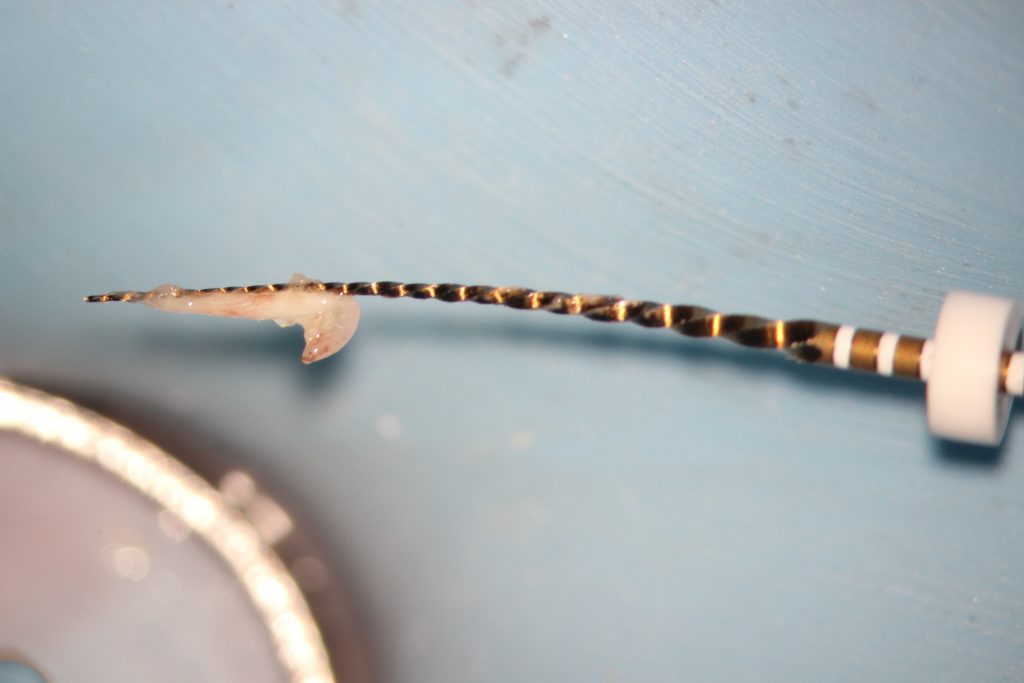Recently a new glide path file was introduced to the market by DenstplySirona called WaveOne Gold Glider. This glide path nickel titanium file works in a unequal bidirectional reciprocating fashion. The tip of the file is equal to a #15 and has a variable taper. The WaveOne Gold Glider is designed to cut an open glide path in an extremely safe and efficient manner. The glide path shape also enhances the efficiency of the WaveOne Gold shaping file and other shaping files like Vortex Blue (2 of my personal favorites). The WaveOne Gold Glider comes in a gold wire nickel titanium that is heat treated and is extremely flexible and resistant to cyclic fatigue. These file design principles equal less file separation and thus more confident clinicians.
I am a huge fan of the ProGlider, a rotary glide path file with a 0.16 tip and variable taper made of M-wire NiTi. I have been using ProGlider to obtain an efficient and safe open glide path for years (ever since it came out) and have used it thousands of times. I have separated this file on two occasions and on both of those it was a second or third use (bad boy!). To date I have not separated a new ProGlider and highly recommend new Niti for new cases. Follow the principles of the Root Canal Playbook from the 4 Quarters of the Root Canal Game and you will greatly reduce if not eliminate file separation.
So when the WaveOne Gold Glider came out I was very excited because I love new and improved technology and I wanted to know if it performed as well or better than the ProGlider. I am currently 200+ cases in using the WaveOne Gold Glider and can confidently say that it’s as good and possibly better than the ProGlider (and I love the PG). This file has numerous kickass characteristics. It all starts with gold wire and in my opinion heat treated gold or blue wire (WaveOne Gold, ProTaper Gold, Vortex Blue- DentsplySirona) are some of the best NiTi’s on the market. This specially treated NiTi wire makes it more resistant to cyclic fatigue and thus more resistant to file separation. The WaveOne Gold Glider is also a reciprocating NiTi file that mimics the technique of hand filling to safely negotiate down the canals. It has a parallelogram cross section similar to the WaveOne Gold that only contacts the canal wall in 2 spots at any given time. It has a 0.15 Tip size and comes in lengths 21, 25, and 31mm. It has a shortened shaft length of 11mm making it easier to insert into the canal. It is made for single use and once sterilized the white plastic ring will swell and it will not fit back into the ProMark or IQ X-Smart Hand piece. Obviously, you can always cut the white plastic piece off the handle with a carbide and the file will then fit nicely into the hand piece. But again, I recommend new Niti files when using new cases (the material overhead is very low for a root canal verses the production).
So Let’s talk about technique: First, locate canals and confirm coronal glide path or working width with a #10 and a #15 K file (just place it into the canal 10-15mm). Now open up the orifice with a Niti orifice opener (I recommend the Vortex 25/08 or 25/10 from DentsplySirona), and negotiate down to patency with a #8 or #10 K file (no small feat), obtain an accurate working length, and work up the #10 K file so that it is LOOSE at working length. Once you have a loose #10 K file to working length than it is GO TIME! At this point I am celebrating because I feel that I own this canal that I will be able to open my glide path and shape this canal in minutes. Now irrigate with bleach and start advancing down the canal with the WaveOne Gold Glider until you hit some resistance (sides of the canal wall). Once you hit resistance continue for another 3-4mm (cutting phase) to allow the file to engage the canal and then cut the canal wall. Disengage back 3-4mm and then reengage another 3-4mm but deeper down the canal. Perform 4-5 engagement/disengagements, pull-out and re-irrigate with 3-6% bleach and check patency with a #10 K file (recapitulate). Again, perform 4-5 engagement/disengagements until you reach working length with the WaveOne Gold Glider. I like to touch and brush the working length 3-4 times just to make sure the glide path is open. Pull the file out and re-irrigate with bleach and check patency. Typically I can reach working length on simple to medium difficult cases in one pass (4-5 engagement/disengagements) which makes obtaining an open glide path very very efficient. Once an open glide path is achieved with the WaveOne Gold Glider than it is really GO TIME! to start shaping with the WaveOne Gold Primary. I have noticed that the shaping with the WaveOne Gold Primary is even more efficient after using the WaveOne Gold Glider to obtain an open glide path.
Happy Glide Path Shaping!
Keywords: WaveOne Gold Glider, Glide Path, WaveOne Gold
